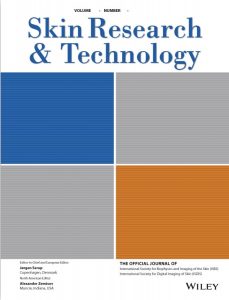Publications

An evaluation of mechanical and biophysical skin parameters at different body locations
Authors: Anto J. U. K. John 1, Francesco Del Galdo 2, Rodney Gush 3, Peter R. Worsley 1
Affiliations:
- School of Health Sciences, University of Southampton, Southampton, UK
- Raynaud’s and Scleroderma Programme, NIHR Biomedical Research Centre, Leeds Institute of Rheumatic and Musculoskeletal Medicine, University of Leeds, Leeds, UK
- Moor Instruments, Axminster, UK
Journal: Skin Research & Technology - February 2023, Volume 29, Issue 2, Article no. e13292 (DOI: 10.1111/srt.13292)
-
Field & Applications:
- Medical
- Skin / Dermatology
- Normatives
- Reliability
Background: Skin is the largest organ in the body, representing an important interface to monitor health and disease. However, there is significant variation in skin properties for different ages, genders and body regions due to the differences in the structure and morphology of the skin tissues. This study aimed to evaluate the use of non-invasive tools to discriminate a range of mechanical and functional skin parameters from different skin sites.
Materials and methods: A cohort of 15 healthy volunteers was recruited following appropriate informed consent. Four well-established CE-marked non-invasive techniques were used to measure four anatomical regions: palm, forearm, sole and lower lumbar L3, using a repeated measures design. Skin parameters included trans-epidermal water loss (TEWL), pH (acidity), erythema, stratum corneum hydration and stiffness and elasticity using MyotonPRO (skin and muscle probe). Differences between body locations for each parameter and the intra-rater reliability between days were evaluated by the same operator.
Results: The results indicate that parameters differed significantly between skin sites. For the MyotonPRO skin probe, the sole recorded the highest stiffness value of 1006 N/m (SD ± 179), while the lower lumbar recorded the least value of 484 N/m (SD ± 160). The muscle indenter MyotonPRO probe revealed the palm’s highest value of 754 N/m (± 108), and the lower lumbar recorded the least value of 208 N/m (SD ± 44). TEWL values were lowest on the forearm, averaging 11 g/m2/h, and highest on the palm, averaging 41 g/m2/h. Similar skin hydration levels were recorded in three of the four sites, with the main difference being observed in the sole averaging 13 arbitrary units. Erythema values were characterised by a high degree of inter-subject variation, and no significant differences between sites or sides were observed. The MyotonPRO skin probe showed excellent reliability (intra-class correlation coefficients > 0.70) for all sites with exception of one site right lower back; the MyotonPRO muscle probe showed good to poor reliability (0.90–017), the Corneometer showed excellent reliability (>0.75) among all the sites tested, and the TEWL showed Good to poor reliability (0.74–0.4) among sites.
Conclusion: The study revealed that using non-invasive methods, the biophysical properties of skin can be mapped, and significant differences in the mechanical and functional properties of skin were observed. These parameters were reliably recorded between days, providing a basis for their use in assessing and monitoring changes in the skin during health and disease.
Keywords: biophysical parameters, functional properties, hydration, mechanical loading, mechanical properties, sensitivity analysis
This study examined baseline values measured at four body sites on the right and left sides, using well-reported, CE-marked commercial devices, and reliability was also evaluated. The study showed marked differences in mean baseline values between different sites of the body. Out of all the skin parameters, the MyotonPRO skin probe, muscle probe and Corneometer were found to be reliable in identifying differences in most skin sites. On the other hand, TEWL and Mexameter proved less reliable. The study revealed that by using non-invasive methods, the biophysical properties of the skin can be mapped, and normal ranges can be generated for healthy volunteers. On this basis, skin health could be assessed using these devices in future studies in patients with skin conditions including scleroderma and atopic dermatitis.


